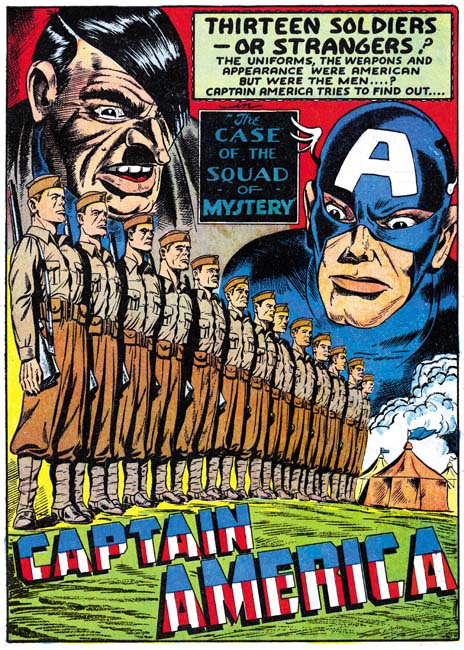
Captain America #11 (February 1942) “The Case of the Squad of Mystery”, pencils by Al Avison
Any discussion of Captain America really should start with those issues that Simon and Kirby created. Not only were they the creators but during the golden age of comics nobody did Captain America like Simon and Kirby. However I am not yet ready to cover Simon and Kirby’s Cap in a manner the material deserves. Instead I will pick up after Joe and Jack were summarily dismissed, that is once they had completed issue #10. But when they left Timely, Simon and Kirby left behind the staff that they had put together. Stan Lee, previously little more than a gopher, became the editor, Al Avison became the associative editor and primary artist, and Syd Shores would do the inking. All were pretty new to the business but Avison had also been doing some work for Harvey Comics and the experience made him a better artist (Al Avison on Speed, Avison Takes on More Speed, Speed Comics #16, Pocket Comic #3) . Actually Avison’s work for Harvey seems comparatively primitive and his talent seemed to blossom once Simon and Kirby were gone.
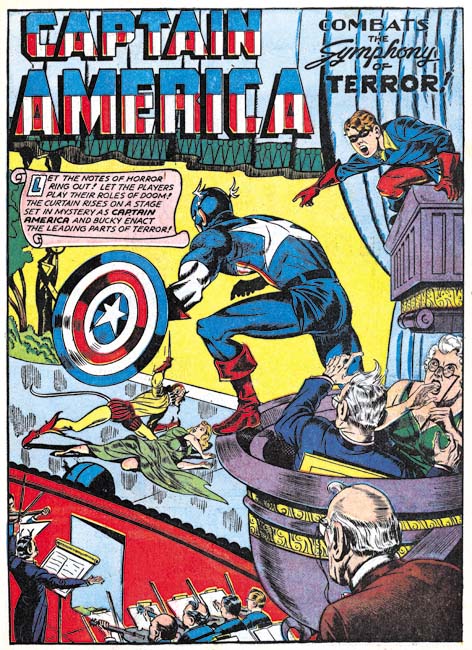
Captain America #11 (February 1942) “The Symphony of Terror”, pencils by Al Avison
Avison learned a lot from Simon and Kirby to the extent that some mistakenly believe that Kirby supplied layouts for some of his work (Al Avison Did Not Need Any Help). Simon and Kirby used irregularly shaped panels when they did Captain America and Avison continued to use them. The art in Simon and Kirby Captain America often extended outside the panel borders and Al kept that device as well. Avison even continued to occasionally provide double page splashes that previously been used so effectively by Joe and Jack.

Captain America #12 (March 1942) “Rozzo the Rebel” page 11, pencils by Al Avison
Simon and Kirby became justly famous for all the wonderful action they put into Captain America. Now I am not going to claim that Avison handled action as well as Joe and Jack, but you can tell he was trying. Not only trying but doing a better job of it than most of his contemporaries. Avison was also keen to try new techniques. For example the page from “Rozzo the Rebel” shown above where Al places three stages of the action into a single page size panel.

Captain America #14 (May 1942) “The Petals of Doom”, pencils by Al Avison, inks by Syd Shores
While Al Avison seemed to have learned a lot from Simon and Kirby, Syd Shores did not learn enough. Shores certainly did most, perhaps all, the inking of Avison’s pencils. Unfortunately Shores had not learned the art of restraint from Simon and Kirby. Too much detailed inking can deaden a piece of comic book art and that is an error that Shore often fell into when inking Captain America. But I do not want to leave the impression that Shores could not do a good job. I particularly admire the splash for “The Petals of Doom”. Despite the over use of fine ink lines, Shores still manages to make the foreground figures stand out. The phantom figure in the background is made more ghostly by the adding white lines over the regular inking lines (probably by dragging the corner of a razor blade).
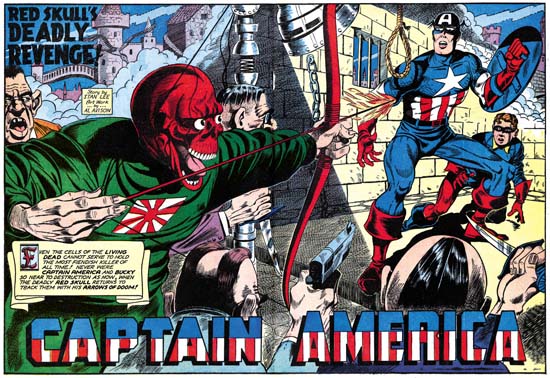
Captain America #16 (July 1942) “Red Skull’s Deadly Revenge”, pencils by Al Avison
Larger Image
As previously mentioned, Stan Lee did not occupy a very high position in the Simon and Kirby studio. His only contribution to the comics were some of the text only features (ignored by almost all readers) and scripts for the backup features. It is clear that Lee made no real contributions to the Captain America featured stories while he was working for Simon. All that changed with the departure of Simon and Kirby. Stan Lee became the editor and would write at least some of the Cap stories. How many of them is an open issue. Some experts claim that Stan Lee signed everything he wrote. However that seems to me to be an extreme position that should be backed up with good evidence. I am unable at this time to hazard a guess whether some of the unsigned Captain America stories were scripted by Lee but fortunately there are also some signed pieces. Perhaps the best was “Red Skull’s Deadly Revenge”. With this story Stan had already advanced beyond most of his peers. It certainly is my favorite golden age Captain America story not done by Simon and Kirby. It has been reprinted not only in the Captain America golden age archives but also in the Stan Lee Visionary volume. “Red Skull’s Deadly Revenge” has a special place in my heart because it was the first piece of comic book art that I ever restored.

Captain America #17 (August 1942) “Sub-Earthmen’s Revenge”, pencils by Al Avison
The Captain America stories are very imaginative. Filled with alligator men, Martians, subsurface dwellers, and other villains. In the end most of the more bizarre advisories would turn out to be a costume wearing Nazi spies. This was very much in keeping with the earlier version by Simon and Kirby.
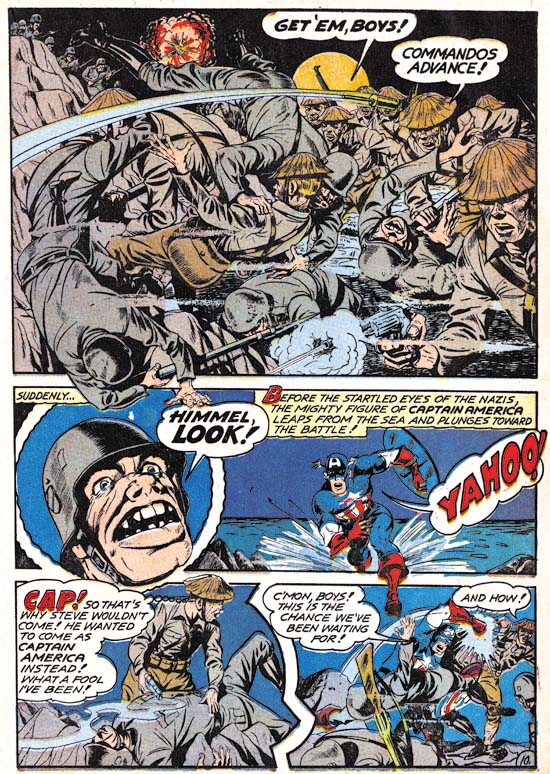
Captain America #19 (October 1942) “On to Berlin” page 10, pencils by Al Avison, inks by Syd Shores
Today Captain America is often called a super-soldier but that description is quite incorrect for the S&K and most Avison stories. Captain America and Bucky fought spies not enemy soldiers. That is until “On to Berlin”. Here Cap joins the storming of a beach. But joining is the proper description, Captain America did not lead the charge. Also note that Cap does not sport a rifle, pistol, knife or other hand weapon. The lack of weaponry is not a response to a moral position against such violence because in panel four there is Bucky (without his superhero costume) holding a recently fired handgun. Neither Simon and Kirby nor Avison every showed Captain America using a hand weapon other than his shield.
Captain America #19 marked Avison’s last issue before he begin his own military service. Starting in the next issue Syd Shores would replace Avison as the primary artist for Captain America. I will discuss Shores contribution next week. I have not forgotten that there are further posts to write in order to finish up my series on Police Trap. All I can say is I do like to mix up the subject of posts. But right now for some inexplicable reason I just cannot get Captain America out of my mind.


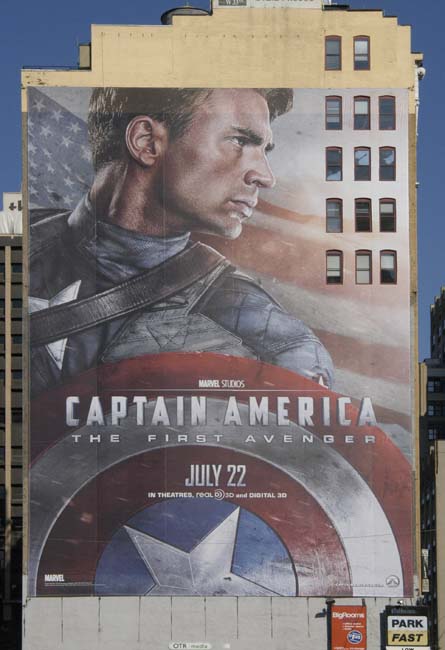
I think the comment that Stan Lee always signed what he wrote and only wrote what he signed has been researched and proven enough for the fifties. I have never heard anyone say it would therefor go fot the forties as well and it would be silly te do so. Even in the fifties there are exceptions, stories that somehow were not signed and in the case of the parody titles Stan himself responded to a question by me if he didn’t really wrote some of hose unsigned stories with the reply that he remembers writing for Riot specificly. In the forties this practice (and it is no more than that, not a rule) could very well not have been in place yet, or the amount of exceptions could have been greater. Stan Lee’s own style may also not have been evolved enough to be visible to the reader. I do stick by my observation that Stan Lee used thru instead of through always and have not yet seen any story disproving that. He was not the only one, though (as I have seen it popping up with Chapman and Rico as well), so it is not an indicator. But it can be used as a disprover, in my opinion.
I beg to differ. The article that you wrote is the only one I know of that attempts to address this issue. But the claim that Stan Lee signed every thing he wrote had been made well before that without any support. Nor I might add did anyone ever make the distinction that it applied only to the ’50s. As your article suggests, and you repeat here, that there are exceptions. But if there are exceptions then it follows that the “Stan Lee always signed what he wrote” is false and should not be used or repeated. Instead unsigned stories should be compared to signed ones for clues as to their correct attributions. I applaued the efforts you have made in this direction. Unfortunately your article did not examine some of the most interesting stories such as the late 40’s Captain America. I will be discussing them in a few weeks, although probably without writer attributes.
Funny enough I didn’t originate the theory, but took it from Doc V. He never researched it more fully, as you say. I exclused the forties, because I couldn’t get enough material from the forties (although that is slowly changing). I hope your research finds more about that. I agree that I can hardly be expected to be my own confirmation on this, but unfortunately no one has done any further reserach, comparing my findings to Stan Lee’s writing in the sixties, for example. Apparently it is easier to cast doubts than it is to confirm hunches. Still, important work such as the Who’s Who was just as much based on research as on hunches. It is not infallible, but a good start. I am not putting up a fight to slight you, as I consider you one of the four best comic history researcher currently doing work. But I ache for a forum to discuss these theories and the doubts surrounding them. If there was such a forum, one of the first things I would say is that I did see a huge sampling of stories (about 70%) from the fifties and the exceptions I found are too few to discredit the whole working hypothesis for the moment. I am talking about two or maybe three unsigned stories over ten years… but that is not for here and if you want to skip this or remove the comments, I wouldn’t mind.
I realize you did not originate the theory, and in fact when I made my original statement I was not referring to your article but to previous statements that have been made for years over the Internet. But it seems we have a different interpretation as to the findings that you reported in your article. I take the exceptions that you found as an indication that the claim “Stan Lee signed everything he wrote” as false, you appear to take the rarity of the exceptions as a indication the statement is basically true. But can you really claim that the unsigned Atlas stories that you have not attributed to Lee could not have possibly been writen by him? I realize in some cases you can make such a claim, but in all cases?
But keep in mind that you have zeroed into one small statement in my original post. Captain America is the subject of that and some posts to follow, not Stan Lee. The question of Stan Lee as a writer will come up again, but I am afraid I have no definitive conclusions to make, only questions to raise.
Hey, I am glad for anything I have to add to your always excellent posts. I read them every week and go back to some of the earlier ones regularely. I am looking forward to the continuation of the Captain America years and I hope you will note some of the artistic differences between Avison and Shores. Did your research give you any new insights into who did what in the Simon and Kirby years?
That Symphony of Terror splash looks like it was composed using lots of Kirby reference. Kind of unusual because nothing else you posted hints at Kirby.
Since Shores worked for Simon and Kirby it is not surprising that conciously or unconciously S&K would influence his work. What is surprising is how little of that influence comes out. Avison picked up much more from Joe and Jack.